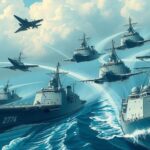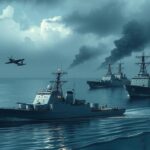Day 2 of PLA Military Drills in Taiwan Strait Highlights Blockade Focus
The second day of the PLA’s military exercises in the Taiwan Strait focuses on tasks like verification and interception. The drills serve as a warning against Taiwanese independence, with Beijing viewing Taiwan as part of China. The United States, while not recognizing Taiwan’s independence, is committed to its defense against potential forceful actions by China.
The People’s Liberation Army (PLA) has entered the second day of its military exercises in the Taiwan Strait, continuing its operations under the code name Strait Thunder-2025A. According to Senior Colonel Shi Yi, spokesman for the PLA’s Eastern Theatre Command, these drills encompass tasks such as verification and identification, warning and expulsion, interception, and detention.
Commencing on Tuesday, these extensive military and coastguard exercises are described by Beijing as “a stern warning and a strong deterrent to the separatist forces of Taiwan independence”. The Chinese government perceives Taiwan as an integral part of China, asserting its intent to achieve reunification, potentially by force if deemed necessary.
The international community, including the United States, largely does not acknowledge Taiwan as a sovereign nation. Nevertheless, the U.S. firmly opposes any military force used against Taiwan and upholds its commitment to provide defense supplies to the island.
As per reports from the Taiwanese defense ministry’s social media updates, a total of 76 PLA sorties and 15 warships, alongside four official vessels, have been observed operating in proximity to Taiwan as of Wednesday morning.
In conclusion, the ongoing PLA military drills in the Taiwan Strait signify China’s robust stance on Taiwan, intending to assert its claims while serving as a warning against any independence movements. While most nations, including the U.S., do not recognize Taiwan as independent, they remain alert and committed to supporting Taiwan’s defense against potential aggression.
Original Source: www.scmp.com








Post Comment